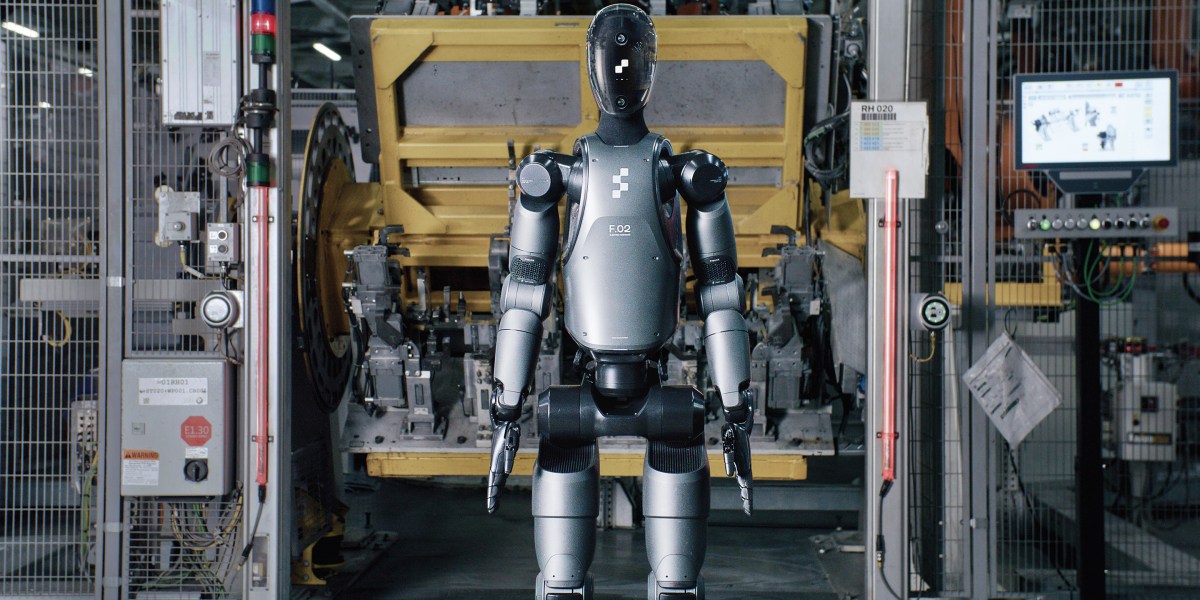When Figure AI, a high-profile humanoid robot startup, announced a commercial agreement with automaker BMW early last year, it was a signal to venture investors and the rest of the robotics industry that the young company was one of the innovators to watch – and to beat – in this cutting edge sector.
Recent comments by Figure founder and CEO Brett Adcock, along with videos produced by the company, gave the impression that a new era of robo-manufacturing was firmly at hand. But a closer look at the details of the partnership reveals a far more modest affair – at least currently – that suggests Figure’s humanoid car-building workforce may be as much hype as reality and which raises questions about the sincerity of Adcock’s comments.
Up until sometime in March, a Figure robot at BMW’s South Carolina factory operated only during off-hours, practicing picking up and placing parts in the plant’s body shop, according to a BMW spokesperson — even though Adcock boasted in February that a “fleet” of Figure’s humanoid robots were already performing “end-to-end operations” for the carmaker. More recently, that same robot work has moved into live production hours but involves a single Figure robot performing the same limited chore, the spokesperson said.
BMW declined to comment on the disparities between what Adcock had publicized in February and what the auto giant said was the reality at the time, referring those questions to Adcock. The serial entrepreneur and representatives for the company have not responded to requests for clarification or comment.
The questions come as sci-fi like humanoid robots are having a moment. While Elon Musk-directed efforts to build a humanoid called Optimus inside Tesla has played a central role in building hype for the futuristic form factor, Figure’s commercial agreement stood out as one of the first real-world deployments in the U.S. Figure has raised more than $700 million since its 2022 founding from investors including Microsoft, Nvidia, Intel Capital, and Jeff Bezos, via his investment firm. Reuters reported in February that Figure AI was attempting to raise another $1.5 billion at a valuation approaching $40 billion.
Other tech giants, from Nvidia to OpenAI, have all launched robot-focused initiatives as expectations build for a potential market opportunity that investment management firm ARK pegged in the trillions of dollars in a bullish report last fall. Agility Robotics, which inked a deal for its own humanoids to move containers inside a Spanx apparel warehouse, is reportedly raising $400 million. That comes after Austin-based Apptronik and Sunnyvale, Calif.-based X1 recently raised $350 million and $100 million in funding, respectively.
When Figure announced the BMW partnership in January of 2024, a press release described the agreement as “a milestone-based” staged approach. While Figure referred to a “commercial” agreement, none of the parties have disclosed the financial terms nor duration of the deal.
How many droids make a ‘fleet’?
Among the mechanical bipeds vying for a piece of the pie, Figure’s humanoids are among the sharpest-looking. Compared to some of the bulkier or clumsy-looking droids made by other companies, the matte-gray-and-black Figure 02 model cuts a sleek figure, with six cameras for eyes, on-board AI, and hands dexterous enough to pour a glass of milk.
In February, Adcock reminded his LinkedIn network that the BMW deal had been inked one year earlier, writing, “We signed our first commercial customer, BMW, a year ago,” his LinkedIn post read. “We currently have a fleet of robots performing end-to-end operations.”
At the time, I reached out to BMW to try to get more details on the fleet of robots and what the end-to-end operations entailed. To my surprise, though, BMW spokesperson Steve Wilson said there was only a single Figure robot working in their South Carolina auto plant at any given time, and that the humanoid was picking up and maneuvering parts “during non-production hours.” When later pressed, Wilson would not say if these one-robot tests were due to there being just one solitary Figure humanoid at the factory, or if the carmaker had multiple Figure humanoids taking turns practicing tasks.
He added that “very soon, the Figure robot will begin loading parts for short intervals during live production,” but declined to offer a more specific timeline. This would be similar work to that which was being tested in off-hours, but in a real production environment.
The production-hours work that Figure’s humanoid would eventually do, Wilson explained, would involve a single robot performing a single task at any given time, in the plant’s body shop – where metal sheet panels are eventually assembled to form the vehicle’s chassis. According to Wilson, the robot would pick up “parts with two hands from a logistics container and place the parts onto a fixture” inside a contained work cell where another type of robot would “begin welding the parts together.” It sounded like a far more limited job than the “end-to-end operations” that Adcock said his droids were already doing.
In early March, Adcock discussed the BMW deal while speaking at a conference. “We actually have them running everyday now,” he said of the humanoids. “They’re there today running in their largest plant.” It’s not clear if BMW had by then started using Figure’s robot technology for production work, but even if it were the case, Adcock’s description once again seemed to stretch the scope of the project versus what was described by the BMW official.
Turn the music up!
On Monday, Adcock posted a new video to LinkedIn that made clear the Figure humanoid was now officially doing production work at BMW’s factory. “BMW X Figure Update,” the CEO said. “This isn’t a test—this is what autonomous robots in production operations look like. Turn the music up!”
The video indeed displayed the type of work that the BMW official had described–a Figure robot retrieving metal pieces from a mobile shelf, and then walking them over to a work cell where it places them onto a fixture in preparation for welding by other automated equipment. A second Figure robot stood idle next to the one performing the task, before the video zoomed out to show a highly automated plant of which Figure is currently playing a small role.
Was that second robot part of the “fleet” that Adcock had described, and would it swing into action when the first humanoid ran out of juice? Or was it just a marketing prop? BMW wouldn’t say and Figure is not responding to queries.
No one, especially BMW, is denying that the partnership with Figure is real, nor that the luxury car brand is testing use of the humanoid robot in one of its plants. In fact, Wilson, the BMW spokesperson, said the company will reveal more details during an onsite press event in May.
But the seeming discrepancies in such a high-profile and potentially seminal deal raise awkward questions for an industry that still needs to prove it’s more than just glossy demo videos and founder-fueled hype. When it comes to humanoids, as with humans, trust is key.
This story was originally featured on Fortune.com
Source link

 Entertainment8 years ago
Entertainment8 years ago
 Politics8 years ago
Politics8 years ago
 Entertainment8 years ago
Entertainment8 years ago
 Entertainment8 years ago
Entertainment8 years ago
 Tech8 years ago
Tech8 years ago
 Tech8 years ago
Tech8 years ago
 Tech8 years ago
Tech8 years ago
 Politics8 years ago
Politics8 years ago







